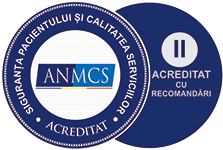An eye examination at least once a year will help prevent serious eye conditions. For example, glaucoma, an extremely serious condition that doesn’t hurt at first and affects around 120,000-140,000 Romanians, can lead to blindness if not treated correctly.
Go to the ophthalmologist, even if you see perfectly!
Many eye conditions have no symptoms at first, and among them are the most serious ones such as glaucoma, eye strain, retinopathy (a complication of diabetes) and macular degeneration.
Here are the most common symptoms that may indicate a problem:
1. Lights, circles, shadows or “a grey wave over the eye” – can indicate retinal detachment, which may be caused by glaucoma or a serious blow to the eye;
2. Temporary and sudden loss of vision. Even if it happens suddenly and returns just as quickly, it can be caused by a number of eye diseases: age-related macular degeneration (which is the leading cause of blindness in people over 65) or a type of glaucoma (characterised by increased intraocular pressure and decreased visual acuity);
3. Eye pain. According to the specialist, most eye conditions do not hurt, but there are times when you may experience eye pain, such as glaucoma, dry eyes, eye injury, corneal erosion (scratching) or eye cancer.
4. Eye strain. Any eye injury should be examined by an ophthalmologist, especially if the symptoms include eye redness and pain lasting more than 15 to 20 minutes;
5. Persistent eye discomfort. After performing an activity that involves a hazard to your eyes due to particles that could enter, it is best to have an ophthalmological examination to avoid a possible eye infection;
6. Red eyes. “If you have both red eyes it is very possible that there is nothing serious, but I can’t say the same about one red eye“, warns the ophthalmologist. If both eyes are red, it could be a cold or conjunctivitis, but if the redness is in one eye, it could be caused by a deep inflammatory process, such as scleritis (inflammation of the eye sclera) and uveitis (inflammation of the inside of the eye).
7. Discomfort when wearing lenses. Most people who wear contact lenses have no problems if they follow the advice on lens care and use. However, there are also situations where eye infections occur, and if you feel pain, discomfort and red eyes do not hesitate to make an eye examination;
8. Blurred vision. Even if it is temporary, a blurred vision should alarm you, because it can hide serious problems such as glaucoma, uveitis, retinal detachment or macular degeneration. Also, blurred vision in one eye can be an early symptom of a heart attack, says the ophthalmologist;
9. Complications following eye surgery. If you experience redness, pain, or a frozen look, it is recommended that you seek an ophthalmological consultation.
What happens at a routine eye examination?
The doctor will ask you a few questions about your medical history, after which you can expect some routine tests:
- visual acuity measurement (the ability of the eye to see an object of a certain size at a specified distance;
- measurement of eye strain using tonometry, a test that is performed by anaesthetising the eyeball with eye drops.
- checking the pupils, cornea, conjunctiva and surrounding tissues. You may need to dilate your pupils with eye drops to give your ophthalmologist more accurate information.




 Română
Română English
English